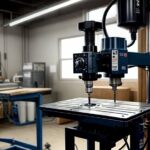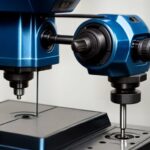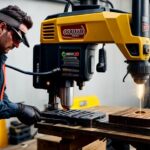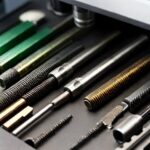The workpiece is held firmly in position during drilling with the help of a drill press vise clamped down. As a result, drilling may be done accurately and precisely since the workpiece won’t move or shift when drilling.
If the workpiece is not clamped correctly, it may become loose and produce an uneven or inadequately drilled hole. Additionally, securing the workpiece in a vice enables hands-free drill press operation, which may increase operating safety. Additionally, it makes it simpler to work on the object while seated comfortably.
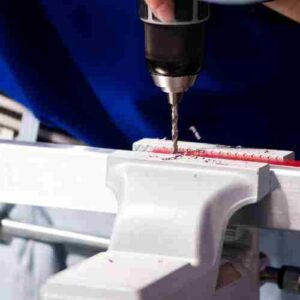 How do you clamp down a drill press vise?
How do you clamp down a drill press vise?
1. Selecting the appropriate clamping tool:
When clamping down a drill press vise, choosing the proper clamping tool is crucial. This can be a standard wrench, a pipe wrench, or a unique clamping lever. Choosing a tool that can provide sufficient torque to firmly hold the workpiece in place while also being convenient to grasp and operate is crucial. Additionally, the tool’s size must match the workpiece and the vise.
2. Setting up the workpiece in the vice:
For accurate and precise drilling, the workpiece must be set up correctly in the vise. The drilling site should match the center of the vise jaws when the workpiece is placed in the middle of the jaws. Doing this lets you ensure the drill bit is focused on the workpiece and won’t veer off while drilling. To avoid harming the workpiece or having an uneven clamping, it’s also crucial to check that the workpiece is level and that the vise’s jaws are not warped.
3. Setting the vise jaws to the size of the workpiece before clamping:
The vise jaws should be set to the size of the workpiece. The screw or lever on the vise may be adjusted to do this. The jaws should be close to the workpiece but not so close that they cause it to deform. Additionally, it’s crucial to check that the workpiece is level in the vise and that the jaws are parallel.
4. Hand tightening:
The easiest way to secure a drill press vise is by hand tightening. Using the screw or lever on the vise entails manually tightening the jaws. While this technique could be enough for holding small or light workpieces in place, it might need more torque for bigger or heavier workpieces.
5. Adding leverage using a wrench or pipe:
A wrench or pipe may give more leverage for bigger or heavier workpieces when tightening the vise jaws. This may aid in boosting the torque delivered to the vise, giving the workpiece a better grip. To add leverage, a pipe wrench or adjustable wrench may be used to grab the vise handle or screw.
6. Making fast and simple adjustments using a clamping lever:
A clamping lever is a specialized tool that may be used to make quick and simple changes to the vise jaws. It often fastens to the vise’s screw or lever and may be used with one hand, making it simple to adjust the vise while using the other hand to secure the workpiece. This might be a practical choice for people who constantly adjust the vise or work on several components of various sizes.
Safety Precautions:
- Always wear the proper personal protection equipment: When using power instruments like a drill press, safety should always come first. To protect your eyes from flying debris, it’s crucial to wear the proper personal protection equipment, such as safety glasses or goggles, at all times. Your hands may be protected from cuts and injuries by wearing gloves. To safeguard your body from any possible dangers, it’s also crucial to wear suitable attire and closed-toe shoes.
- Clamp the vise firmly to the drill press table: Before starting drilling, it’s crucial to ensure that the vise is firmly attached to the drill press table. To achieve this, either uses the vise’s fastening mechanisms or add more clamps to hold the vise to the table. In addition to creating an uneven or poorly drilled hole, a loose vise poses a safety risk due to its propensity to move during drilling.
- Make sure all parts are secure and tight before using: Before operating the drill press, ensure all parts are solid and tight. This pertains to the chuck, drill bit, and vise jaws. Uneven or poorly drilled holes might result from loose or worn components causing the drill press to vibrate excessively or the drill bit to wander. Additionally, ensure the belt is set and well-tensioned and the drill press is well-oiled.
Frequently Asked Questions (FAQs)
What is the purpose of a drill press vise?
A drill press vise is used to hold a workpiece securely in place during drilling operations on a drill press. It ensures that the workpiece does not move or shift, allowing for accurate and precise drilling.
Can I use a regular bench vise instead of a drill press vise?
While it is possible to use a regular bench vise with a drill press, a drill press vise is specifically designed for this purpose and provides better stability and precision. A drill press vise is typically more compact, has jaws designed for holding various workpieces, and can be easily clamped to the drill press table.
How do I choose the right size drill press vise for my workpiece?
To choose the right size drill press vise, consider the size and shape of your workpiece, as well as the type of drilling operation you’ll be performing. The vise should be large enough to securely hold the workpiece without obstructing the drill press operation. The vise jaws should also be able to open wide enough to accommodate the workpiece.
Do I need to use any additional clamps to secure the vise to the drill press table?
While many drill press vises come with built-in clamping mechanisms, it is recommended to use additional clamps to ensure the vise is securely fastened to the drill press table. This prevents the vise from moving during drilling operations and ensures a safer working environment.
How often should I inspect and maintain my drill press vise?
It is important to inspect and maintain your drill press vise regularly to ensure its proper functioning and longevity. Check for any signs of wear, damage, or misalignment in the vise jaws and clamping mechanisms. Clean and lubricate the moving parts of the vise as needed, and tighten any loose screws or bolts. It is recommended to perform these maintenance tasks every few months or more frequently, depending on the frequency of use and the type of work being done.
Final Words:
On a drill press, accurate and precise drilling depends on the proper clamping technique. It guarantees that the workpiece is firmly kept in place and prevents it from shifting or moving while drilling is being done. Additionally, it enables hands-free use of the drill press, which might increase operational safety.
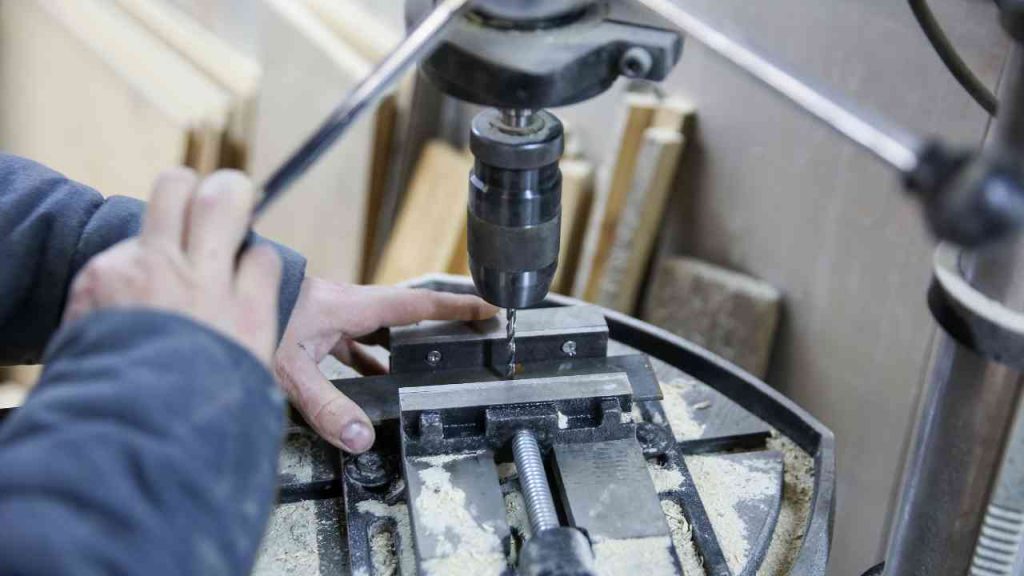
As usual, while using power tools, safety should come first. Always wear the proper personal safety equipment, fasten the vise to the drill press table, and ensure that all parts are securely fastened before usage. To guarantee a secure and effective drilling experience, keep in mind to take your time and work cautiously.
- Where are WEN drill presses made? - April 2, 2023
- Where are Rikon drill presses made? - April 1, 2023
- Where are Powermatic drill presses made? - April 1, 2023


